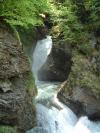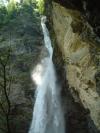




The Reichenbach Falls, above Meiringen, are not only worth seeing in themselves but also because they are the setting for Conan Doyle's Sherlock Holmes story, "The Final Problem", in which Holmes and Moriarty meet on an upper ledge of the Reichenbach Falls, fight, and fall to their deaths.
The story, first published in 1893, has received stern criticism from demanding readers, on the ground that Conan Doyle states that any attempt at recovering the bodies would be "absolutely hopeless" - thereby leaving himself a loophole, of course, for a subsequent discovery that Holmes survived after all. The waterfall itself is very impressive but the actual amount of water flowing down it is not usually very large, and the river flowing from the bottom of the falls to the river Aare is little more than a stream. At most times of the year, the flow would not be sufficient to wash a human body into the Aare.
However, the action of the story takes place on a 4th of May. The waterfall is principally fed by meltwater from the mountains to the south of it, which go up to over 3000 metres. The weather in Switzerland can warm up rapidly in May, and warm rain on melting snow can result in the amount of water flowing down Alpine streams multiplying manyfold. The river Aare would also be swollen, and it is at least conceivable that a body could be washed into the Brienzersee, a large lake, without being noticed on the way.
That a human body would simply be washed out of the Brienzersee, into the next lake (the Thunersee), and hence eventually into the Rhine, is not conceivable today. Flow out of the Thunersee is controlled by sluice gates, to prevent flooding, and a body would be recovered. But were the sluice gates present in 1891? I don't know; if you do, drop me an email ...
On to the pictures. Click on the little images to enlarge them.